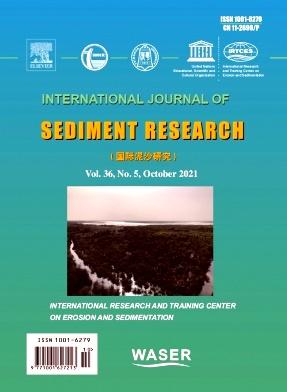On the parameters of common settling velocity models for porous sediment aggregates
IF 3.5
2区 环境科学与生态学
Q2 ENVIRONMENTAL SCIENCES
引用次数: 0
Abstract
The settling behavior of sediment aggregates is a critical factor influencing the transport of fine-grained sediment in riverine and marine environments. Due to the small size and fragile structure of cohesive sediment aggregates, direct measurement of their porosity and permeability is challenging. While porosity often is estimated using settling velocity relations, permeability is frequently overlooked. The current study examines the impact of considering non-negligible permeability on the properties of flocs. Aggregate properties are compared by calibrating experimental data to two settling models in a dilute regime: one assumes a fractal structure of aggregates and neglects permeability, while the other assumes constant porosity and permeability. The current results demonstrate that both models describe the experimental data of highly porous aggregates with similar accuracy. Aggregate dynamics are further investigated in more complex flow conditions using numerical simulations applying a volume penalization method to geometrically resolve flocs. The behavior of permeable and impermeable flocs is compared in dense suspension regimes and during dilute settling in density-stratified environments. The current findings reveal that permeability significantly influences settling dynamics in complex scenarios and should be considered when determining aggregate properties.
多孔泥沙团聚体常用沉降速度模型参数研究
泥沙团聚体的沉降行为是影响细粒泥沙在河流和海洋环境中运移的关键因素。由于粘性沉积物团聚体体积小且结构脆弱,直接测量其孔隙度和渗透率具有挑战性。虽然孔隙度通常使用沉降速度关系来估计,但渗透率经常被忽略。本研究考察了考虑不可忽略的渗透性对絮凝体性能的影响。通过标定实验数据,比较了两种稀释条件下的沉降模型:一种假设集料的分形结构,忽略渗透率,另一种假设孔隙度和渗透率恒定。目前的结果表明,两种模型对高孔隙集料的实验数据的描述精度相似。在更复杂的流动条件下,采用体积惩罚方法进行数值模拟,进一步研究了絮凝体的几何解析。在密集的悬浮液体系和密度分层环境中稀释沉降过程中,比较了渗透和不渗透絮凝体的行为。目前的研究结果表明,在复杂情况下,渗透率对沉降动力学有显著影响,在确定骨料性能时应予以考虑。
本文章由计算机程序翻译,如有差异,请以英文原文为准。
求助全文
约1分钟内获得全文
求助全文
来源期刊
CiteScore
6.90
自引率
5.60%
发文量
88
审稿时长
74 days
期刊介绍:
International Journal of Sediment Research, the Official Journal of The International Research and Training Center on Erosion and Sedimentation and The World Association for Sedimentation and Erosion Research, publishes scientific and technical papers on all aspects of erosion and sedimentation interpreted in its widest sense.
The subject matter is to include not only the mechanics of sediment transport and fluvial processes, but also what is related to geography, geomorphology, soil erosion, watershed management, sedimentology, environmental and ecological impacts of sedimentation, social and economical effects of sedimentation and its assessment, etc. Special attention is paid to engineering problems related to sedimentation and erosion.

 求助内容:
求助内容: 应助结果提醒方式:
应助结果提醒方式:


